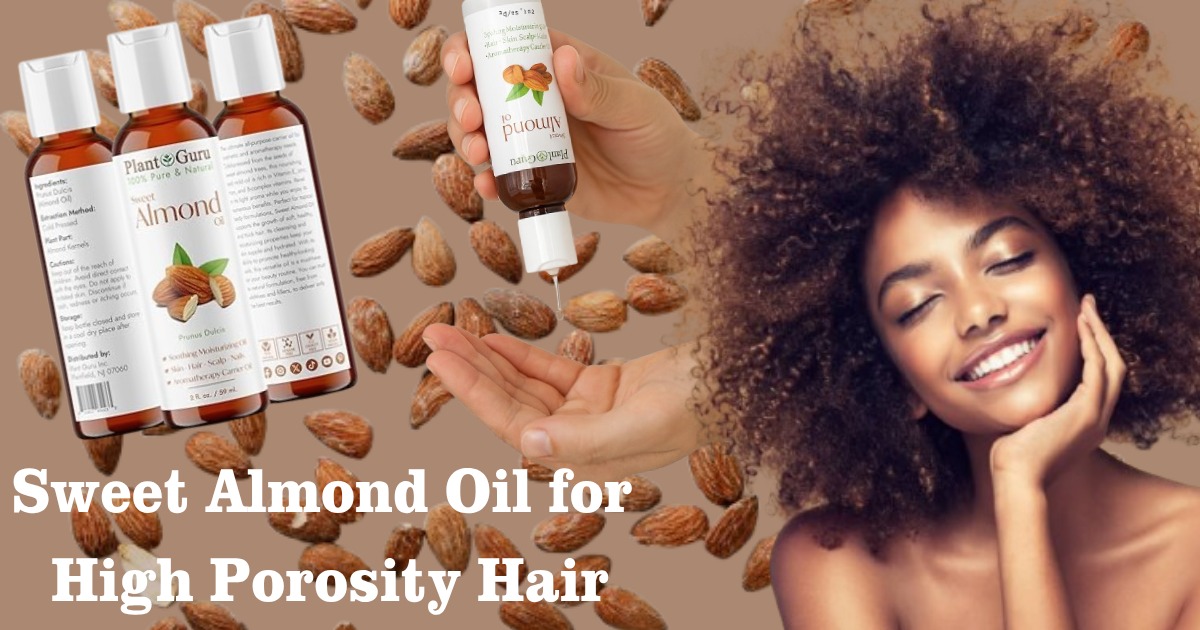Tired of frizz, breakage, and hair that just won’t hold moisture?
If you have high porosity hair, you already know how exhausting it is to keep it soft, hydrated, and manageable.
Sweet almond oil for high porosity hair might be the simple, science-backed solution you’ve been missing.
This lightweight, nutrient-rich oil penetrates fast, seals in moisture, and helps smooth damaged cuticles — without weighing your hair down.
In just a few uses, it can boost shine, reduce dryness, and make your hair feel stronger and more defined.
But not all oils work the same — and using them the wrong way can make things worse.
That’s why in this guide, you’ll learn exactly how sweet almond oil works, how to apply it for best results, and how it stacks up against other oils.
If you’re ready to bring life back to your curls and stop fighting your hair every day, keep reading.
What Is High Porosity Hair?
High porosity hair means your strands have lifted or damaged cuticles — tiny gaps that let moisture in fast but leak it just as quickly.
Think of it like a sponge. Water soaks in easily… but dries out even faster.
A simple float or spray test can help you identify this hair type. Drop a clean strand of hair in a glass of water — if it sinks quickly, your hair likely has high porosity. Or, mist your hair with water. If it absorbs instantly, that’s another sign.
Most often, high porosity isn’t natural. It’s caused by excessive heat styling, bleaching, chemical treatments, or environmental stress.
If your hair feels rough, tangles easily, or frizzes even after moisturizing — open cuticles could be the root cause.
Why It Loses Moisture Fast
Because the cuticle layer is raised or damaged, moisture flows in — then escapes just as easily.
Your hair can’t retain hydration for long, leading to chronic dryness, dullness, and breakage.
To fix this, you need oils or treatments that seal and fill in the gaps along the cuticle surface.
This is where smart oil layering and ingredient choice becomes crucial — starting with lightweight sealants that protect without buildup.
Why Sweet Almond Oil Works for High Porosity Hair
Sweet almond oil is packed with essential fatty acids — especially Omega-9, which helps seal open cuticles, and Omega-3 and 6, which deeply nourish the hair shaft.
Unlike heavier oils, almond oil has a smaller molecular structure. That means it penetrates high porosity hair easily without leaving a greasy film.
It offers a balanced solution: a light seal that helps lock in moisture while delivering essential nutrients from the inside out.
Perfect for daily use or layering under heavier oils.
Vitamins A, D, E and Minerals
This oil is also rich in vitamins A, D, and E, plus minerals like zinc and magnesium — key nutrients for healthy hair and scalp.
Vitamin E helps protect against oxidative stress and environmental damage.
Vitamin D supports scalp balance and hair growth.
And Vitamin A promotes cell regeneration, which keeps strands smooth and strong.
Together, they strengthen weak hair, add shine, and reduce breakage — all while improving overall hair manageability.
Comparison: Sweet Almond vs. Heavier Sealants
Heavy oils like castor, coconut, or olive oil can weigh down high porosity hair, especially fine or wavy textures.
They often sit on the surface, causing buildup or even blocking moisture absorption over time.
In contrast, sweet almond oil strikes the ideal middle ground — it’s lightweight enough for easy absorption but rich enough to seal moisture and smooth frizz.
This makes it perfect as a base oil for LOC or LCO routines, or even as a daily leave-in when used sparingly.
If other oils leave your hair greasy or limp, almond oil might be the game-changing solution your curls need.
How to Use Sweet Almond Oil: Step‑by‑Step Routines
Sweet almond oil is incredibly versatile — and when used correctly, it can completely transform how your high porosity hair looks and feels.
Below are four simple, proven methods to get the most out of this lightweight, moisture-locking oil.
3.1 Pre‑Shampoo / Hot-Oil Treatment
This method deeply hydrates, softens rough cuticles, and preps your strands before cleansing.
Here’s how to do it:
-
Step 1: Warm 2–4 tablespoons of sweet almond oil (not hot — just warm to the touch).
-
Step 2: Dampen your hair lightly or apply to freshly misted strands.
-
Step 3: Massage the oil into your scalp and work it through the lengths of your hair.
-
Step 4: Cover with a plastic cap and wrap with a warm towel.
-
Step 5: Let it sit for 20–30 minutes. Then rinse and shampoo as usual.
Safety tips:
-
Always patch test almond oil before first use — especially if you have nut allergies.
-
Don’t overheat the oil — warm it using a hot water bath, not the microwave.
Benefits: This treatment improves elasticity, minimizes protein loss, and preps hair to retain moisture post-wash.
3.2 Leave‑In or L.O.C. Method
This method locks in moisture and reduces frizz all day long.
Use almond oil as the “O” (oil) in the L.O.C. method:
-
L = Liquid: Start with water or a water-based leave-in conditioner.
-
O = Oil: Apply a few drops of sweet almond oil to damp hair, focusing on mid-lengths and ends.
-
C = Cream: Finish with a cream or butter to fully seal the moisture in.
Tip: Use less oil if you have fine hair — almond oil spreads easily and a little goes a long way.
Benefits: Creates long-lasting moisture retention, improves shine, and prevents dryness between washes.
3.3 Daily Hydration & Sealing Routine
For ongoing frizz control and moisture, use sweet almond oil in your daily refresh routine:
-
Lightly mist hair with water or aloe vera juice.
-
Apply 1–2 drops of almond oil to palms, rub together, and smooth over damp strands.
-
Focus on the ends and edges where hair dries out fastest.
Benefits: Keeps curls soft, shiny, and manageable throughout the day — without buildup.
3.4 DIY Blends & Hair Masks
Get even more from sweet almond oil by mixing it into DIY hair masks and oil blends.
Try these simple recipes:
-
Moisture Boosting Mask:
-
2 tbsp sweet almond oil
-
1 tbsp avocado oil
-
1 tbsp olive oil
-
Apply to clean, damp hair. Leave on for 30 minutes. Rinse.
-
-
Repairing Honey Oil Mask:
-
1 tbsp almond oil
-
1 tbsp raw honey
-
1 egg yolk (optional for protein boost)
-
Mix and apply evenly. Leave for 20–30 minutes under a cap.
-
Benefits: Custom blends help target specific needs — from moisture repair to shine enhancement and breakage prevention.
Using sweet almond oil the right way builds moisture, reduces frizz, and supports long-term hair health — especially for high porosity textures that need consistent sealing and softness.
Sweet Almond Oil vs. Other Oils for High Porosity Hair
Choosing the right oil for high porosity hair isn’t just about what’s trendy — it’s about how well it works with your texture, density, and moisture needs.
Let’s break down how sweet almond oil stacks up against other common oils, so you can make the best decision for your routine.
Comparison Table (Viscosity, Penetration, Sealing Power)
Not all oils act the same. Some penetrate deeper. Others just coat your strands.
Here’s a quick side-by-side to show where sweet almond oil hits the sweet spot:
| Oil | Viscosity | Penetration | Sealing Power | Best For |
|---|---|---|---|---|
| Sweet Almond | Light | Medium-High | Medium | Daily use, moisture sealing |
| Castor | Very Thick | Low | Very High | Ends protection, thick/coarse hair |
| Coconut | Medium | High (protein-rich) | Medium | Repair, protein-loving hair |
| Olive | Heavy | Medium | High | Deep conditioning, brittle strands |
| Avocado | Medium | High | Medium-High | Damaged or color-treated hair |
Why it matters:
Sweet almond oil offers the best balance — it penetrates to nourish without sitting on the surface or weighing hair down.
If your curls feel dry hours after moisturizing, almond oil helps seal moisture and smooth frizz without buildup.
When to Choose Almond vs. Heavy Oils
High porosity hair is thirsty — but your oil strategy should still match your hair type and texture.
Use sweet almond oil alone if you have:
-
Fine to medium strands
-
Low to medium hair density
-
A need for daily moisture sealing
Use heavier oils (or blend with almond oil) if you have:
-
Thick, coarse textures
-
Tightly coiled or natural Type 4 hair
-
Chronically dry ends or high breakage
Pro tip: For thicker textures, layer almond oil first, then seal with castor or avocado oil to lock everything in.
This technique gives you deep nourishment without suffocating the strand.
Advanced Tips & Tricks
Once you’ve mastered the basics, these expert-level techniques will help your hair retain more moisture, stay strong, and look healthy — every single day.
Using Almond Oil with Protein Treatments
High porosity hair often needs protein to rebuild weak, damaged strands.
But protein alone isn’t enough.
Here’s the key:
Apply a protein treatment to fill in gaps along the cuticle. Then follow up with sweet almond oil to seal those proteins in.
This one-two punch strengthens your hair from the inside out, while locking in softness and shine.
Use this method weekly or biweekly depending on your damage level.
Moisture Layering Strategies (Aloe, Glycerin, Oils)
Want longer-lasting hydration? Use the “Humectant → Oil → Cream” method.
Start with a water-based humectant like aloe vera juice or vegetable glycerin to attract moisture.
Then apply sweet almond oil to seal that moisture in.
Finish with a rich leave-in cream or butter to hold everything in place — especially helpful in dry or windy weather.
This method mimics what your high porosity hair lacks: structure, moisture retention, and protection.
Avoiding Buildup & Scalp Issues
Even natural oils can cause itchiness, flaking, or clogged pores if not used right.
To prevent this:
-
Clarify your hair once every 2–4 weeks using a gentle sulfate-free shampoo.
-
Apply almond oil to your strands, not your scalp — unless your scalp is dry.
-
Always patch test almond oil before your first use, especially if you have nut sensitivities.
Buildup suffocates your strands and reduces moisture absorption — the opposite of what high porosity hair needs.
Stay consistent, rinse thoroughly, and your scalp (and curls) will thank you.
Conclusion: Sweet Almond Oil for High Porosity Hair
Sweet almond oil isn’t just another trend — it’s a proven solution for managing high porosity hair. Its lightweight texture, rich nutrients, and sealing ability make it one of the most effective oils for locking in moisture and strengthening weak strands.
Used consistently, it helps reduce breakage, smooth rough cuticles, and restore softness without the weight or buildup.
But here’s the key: balance. A little goes a long way. Start small, adjust based on how your hair responds, and don’t be afraid to mix it with other oils for deeper nourishment.
If your curls still feel dry hours after moisturizing, or frizz keeps coming back — this might be your missing step.
Now it’s your turn. Try almond oil in your routine this week and pay attention to the results.
Have questions? Tried a custom blend that worked? Drop a comment or reach out — your feedback could help someone else perfect their routine too.
FAQs
Is sweet almond oil good for high porosity hair?
Yes — sweet almond oil is excellent for high porosity hair because it seals moisture, smooths raised cuticles, and reduces frizz. Its lightweight texture absorbs easily without clogging the scalp or weighing hair down.
How often should I use almond oil for high porosity hair?
Use almond oil 2–3 times a week for best results. Apply it after moisturizing or during your L.O.C. routine to help retain hydration in high porosity strands.
Can I leave almond oil in my hair overnight?
Yes, you can safely leave sweet almond oil in your hair overnight. It helps repair dryness, reduce breakage, and soften high porosity hair while you sleep.
Can sweet almond oil cause buildup?
Almond oil rarely causes buildup if used in small amounts. However, clarify your hair every 2–4 weeks to remove residue and maintain a healthy moisture balance.
Is almond oil better than coconut oil for high porosity hair?
For many, yes — almond oil is lighter and less likely to harden or cause protein overload. It suits high porosity hair better if your strands respond poorly to coconut oil.
Does almond oil help with hair growth?
Almond oil nourishes the scalp, reduces inflammation, and improves blood flow, which can support healthy hair growth over time.
Can I mix almond oil with other oils?
Absolutely. Sweet almond oil blends well with heavier oils like castor or avocado oil, making it ideal for custom sealing blends or deep treatments for high porosity hair.
Should I apply almond oil to wet or dry hair?
Apply almond oil to damp hair after moisturizing. This locks in hydration and prevents your high porosity hair from drying out too quickly.

Mahian is our dedicated hair growth and hair oil content writer, with years of experience creating in-depth guides on natural hair treatments, oil applications, and hair care routines. Through extensive research and content creation in the hair growth niche, he has developed a deep understanding of various hair oils, their benefits, and practical usage tips. His writing covers everything from traditional oiling methods to ingredient spotlights, helping readers navigate the world of hair growth solutions. Mahian’s passion for the subject and commitment to thorough research make him a trusted voice for anyone looking to improve their hair health through natural methods.

